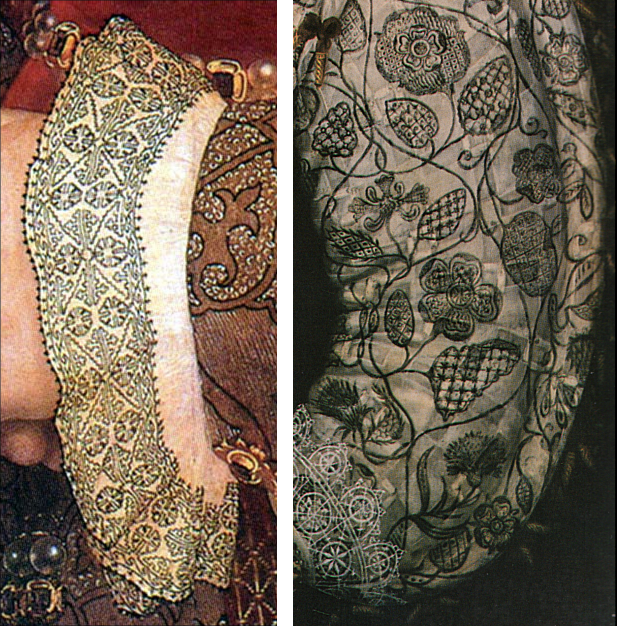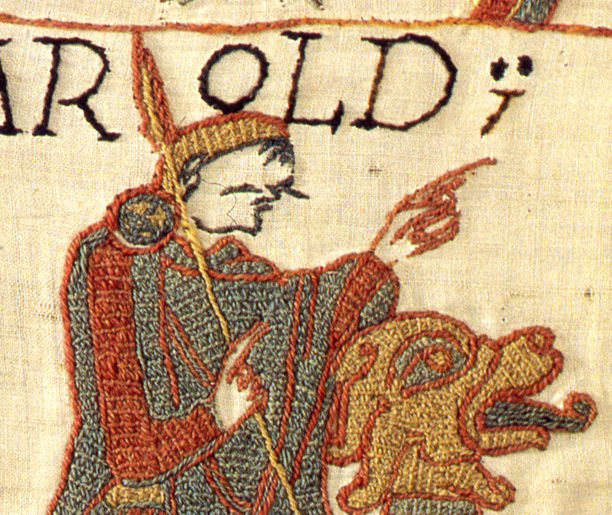|
Holbein Stitch
Holbein stitch is a simple, reversible line embroidery stitch most commonly used in Blackwork embroidery and Assisi embroidery. The stitch is named after Hans Holbein the Younger (1497-1543), a 16th-century portrait painter best known for his paintings of Henry VIII and his children, almost all of whom are depicted wearing clothing decorated with blackwork embroidery. Although superficially similar to Back Stitch the Holbein stitch produces a smoother line and a pattern that is identical on both sides of the fabric. It can be worked in straight lines, diagonally, or in a stepped fashion to make a zigzag line and is well suited to creating outlines or intricate filling patterns. Holbein stitch is also known as ''double running stitch'', ''line stitch'', ''Spanish stitch'', ''Chiara stitch'' and ''two-sided line stitch''. Description of the technique Holbein stitch is usually worked on an even-weave fabric where the threads can be counted to ensure perfect regularity and is wor ... [...More Info...] [...Related Items...] OR: [Wikipedia] [Google] [Baidu] |
Embroidery
Embroidery is the craft of decorating fabric or other materials using a needle to apply thread or yarn. Embroidery may also incorporate other materials such as pearls, beads, quills, and sequins. In modern days, embroidery is usually seen on caps, hats, coats, overlays, blankets, dress shirts, denim, dresses, stockings, scarfs, and golf shirts. Embroidery is available in a wide variety of thread or yarn colour. Some of the basic techniques or stitches of the earliest embroidery are chain stitch, buttonhole or blanket stitch, running stitch, satin stitch, and cross stitch. Those stitches remain the fundamental techniques of hand embroidery today. History Origins The process used to tailor, patch, mend and reinforce cloth fostered the development of sewing techniques, and the decorative possibilities of sewing led to the art of embroidery. Indeed, the remarkable stability of basic embroidery stitches has been noted: The art of embroidery has been found worldwide and ... [...More Info...] [...Related Items...] OR: [Wikipedia] [Google] [Baidu] |
Blackwork Embroidery
Blackwork, sometimes historically termed Spanish blackwork, is a form of embroidery generally worked in black thread, although other colours are also used on occasion, as in scarletwork, where the embroidery is worked in red thread. Originating in Tudor period England, blackwork typically, though not always, takes the form of a counted-thread embroidery, where the warp and weft yarns of a fabric are counted for the length of each stitch, producing uniform-length stitches and a precise pattern on an even-weave fabric. Blackwork may also take the form of free-stitch embroidery, where the yarns of a fabric are not counted while sewing. Traditionally, blackwork is worked in silk thread on white or off-white linen or cotton fabric. Sometimes metallic threads or coloured threads are used for accents. Technique The stitches used for counted thread blackwork are double running or holbein stitch, backstitch, and sometimes stem stitch. Historically, blackwork was worked on plain-weav ... [...More Info...] [...Related Items...] OR: [Wikipedia] [Google] [Baidu] |
Assisi Embroidery
Assisi embroidery is a form of counted-thread embroidery based on an ancient Italian needlework tradition in which the background is filled with embroidery stitches and the main motifs are outlined but not stitched. The name is derived from the Italian town of Assisi where the modern form of the craft originated. Description of the technique Assisi work uses a method known as voiding in which cross-stitch fills the background while the motif itself is left blank. Holbein stitch, a style of linear blackwork, is used to outline and emphasize the motif and to create surrounding decorative scrollwork. Traditionally, Assisi embroidery was rarely executed in cross-stitch but was most often in long-armed cross-stitch. Examples employing other stitches, such as Italian cross-stitch and Algerian plait stitch, are also known. The colours of thread used were red, blue, green or gold for the background and black or brown for the outlines. Traditional motifs were largely heraldic, especially ... [...More Info...] [...Related Items...] OR: [Wikipedia] [Google] [Baidu] |
Hans Holbein The Younger
Hans Holbein the Younger ( , ; german: Hans Holbein der Jüngere; – between 7 October and 29 November 1543) was a Germans, German-Swiss people, Swiss painter and printmaker who worked in a Northern Renaissance style, and is considered one of the greatest portraitists of the 16th century. He also produced religious art, satire, and Protestant Reformation, Reformation propaganda, and he made a significant contribution to the history of book design. He is called "the Younger" to distinguish him from his father Hans Holbein the Elder, an accomplished painter of the International Gothic, Late Gothic school. Holbein was born in Augsburg but worked mainly in Basel as a young artist. At first, he painted murals and religious works, and designed stained glass windows and illustrations for books from the printer Johann Froben. He also painted an occasional portrait, making his international mark with portraits of humanist Desiderius Erasmus of Rotterdam. When the Reformation reach ... [...More Info...] [...Related Items...] OR: [Wikipedia] [Google] [Baidu] |
Henry VIII Of England
Henry VIII (28 June 149128 January 1547) was King of England from 22 April 1509 until his death in 1547. Henry is best known for his six marriages, and for his efforts to have his first marriage (to Catherine of Aragon) annulled. His disagreement with Pope Clement VII about such an annulment led Henry to initiate the English Reformation, separating the Church of England from papal authority. He appointed himself Supreme Head of the Church of England and dissolved convents and monasteries, for which he was excommunicated by the pope. Henry is also known as "the father of the Royal Navy" as he invested heavily in the navy and increased its size from a few to more than 50 ships, and established the Navy Board. Domestically, Henry is known for his radical changes to the English Constitution, ushering in the theory of the divine right of kings in opposition to papal supremacy. He also greatly expanded royal power during his reign. He frequently used charges of treason and ... [...More Info...] [...Related Items...] OR: [Wikipedia] [Google] [Baidu] |
Backstitch
Backstitch or ''back stitch'' and its variants ''stem stitch'', ''outline stitch'' and ''split stitch'' are a class of embroidery and sewing stitches in which individual stitches are made backward to the general direction of sewing. In embroidery, these stitches form lines and are most often used to outline shapes and to add fine detail to an embroidered picture. It is also used to embroider lettering. In hand sewing, it is a utility stitch which strongly and permanently attaches two pieces of fabric. The small stitches done back-and-forth makes the back stitch the strongest stitch among the basic stitches. Hence it can be used to sew strong seams by hand, without a sewing machine. How to do it A versatile stitch which is easy to work, backstitch is ideal for following both simple and intricate outlines and as a foundation row for more complex embroidery stitches such as ''herringbone ladder filling stitch''. Although superficially similar to the Holbein stitch, which is comm ... [...More Info...] [...Related Items...] OR: [Wikipedia] [Google] [Baidu] |
Even-weave
A balanced fabric is one in which the ''warp'' and the ''weft'' are of the same size. In weaving, these are generally called "balanced plain weaves" or just "balanced weaves", while in embroidery the term "even-weave" is more common. Balanced plain weave A balanced plain weave is a fabric in which the warp threads and the weft threads are equally spaced, and are identical or similar in size. In addition to the same sett, the yarn is the same in the warp and weft. The term can be used for a tabby weave or a basketweave. Balanced weaves have also been called "50/50 plain webs", and are a subset of plain weaves. Unbalanced weaves, in which warp and weft differ in size, may be either ''warp-dominant'' or ''weft-dominant'' fabrics. The primary advantage of balanced weaves is that they are potentially stronger than other basic weaves. Even-weave An even-weave fabric or canvas, a term mostly used in embroidery, is any textile where the warp and weft threads are of the same size. Eve ... [...More Info...] [...Related Items...] OR: [Wikipedia] [Google] [Baidu] |
Running Stitch
The straight or running stitch is the basic stitch in hand-sewing and embroidery, on which all other forms of sewing are based. The stitch is worked by passing the needle in and out of the fabric at a regular distance. All other stitches are created by varying the straight stitch in length, spacing, and direction. Some sources only use the term straight stitch to refer to the individual stitch or its family of related stitches, while others use it interchangeably with or in place of running stitch. Running stitch will never be used to refer to a single stitch since a single running stitch is a straight stitch. Running stitches are most often not visible as they are used to close seams. Running stitch, Holbein or double-running stitch, satin stitch and darning stitch are all classed as straight or flat stitches. Backstitch is also sometimes included in this category.Enthoven, Jacqueline: ''The Creative Stitches of Embroidery'', Van Norstrand Rheinhold, 1964, , p. 29-46 ... [...More Info...] [...Related Items...] OR: [Wikipedia] [Google] [Baidu] |
Counted-thread Embroidery
Counted-thread embroidery is any embroidery in which the number of warp and weft yarns in a fabric are methodically counted out for each stitch, resulting in uniform-length stitches and a precise, uniform embroidery pattern. Even-weave fabric is usually used, producing a symmetrical image, as both warp and weft yarns are evenly spaced. The opposite of counted-thread embroidery is free embroidery. Types of counted-thread embroidery Among the counted-thread embroidery techniques are: *Assisi *Bargello, or Florentine work *Blackwork *Canvas work *Cross-stitch *Hardanger *Needlepoint *Drawn thread work See also *Pixel art Pixel art () is a form of digital art drawn with graphics software, graphical software where images are built using pixels as the only building block. It is widely associated with the low-resolution graphics from 8-bit and 16-bit era computers a ... Embroidery {{Textile-arts-stub ... [...More Info...] [...Related Items...] OR: [Wikipedia] [Google] [Baidu] |
Embroidery Stitch
In everyday language, a stitch in the context of embroidery or hand-sewing is defined as the movement of the embroidery needle from the back of the fibre to the front side and back to the back side. The thread stroke on the front side produced by this is also called ''stitch''. In the context of embroidery, an embroidery stitch means one or more ''stitches'' that are always executed in the same way, forming a figure. Embroidery stitches are also called ''stitches'' for short. Embroidery stitches are the smallest units in embroidery. Embroidery patterns are formed by doing many embroidery stitches, either all the same or different ones, either following a counting chart on paper, following a design painted on the fabric or even working freehand. Common stitches Embroidery uses various combinations of stitches. Each embroidery stitch has a special name to help identify it. These names vary from country to country and region to region. Some of the basic stitches of embroidery are r ... [...More Info...] [...Related Items...] OR: [Wikipedia] [Google] [Baidu] |







